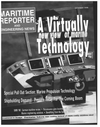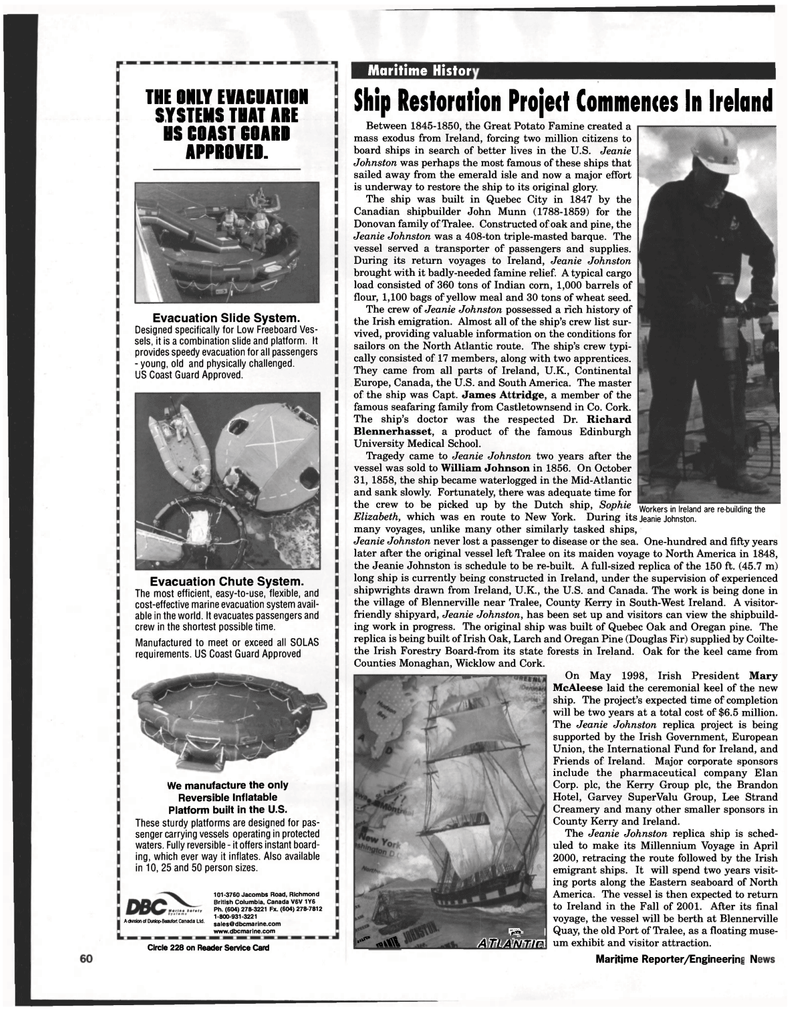
Page 78: of Maritime Reporter Magazine (September 1998)
Read this page in Pdf, Flash or Html5 edition of September 1998 Maritime Reporter Magazine
Maritime Histor 80 Maritime Reporter/Engineerine No»-
THE ONLY EVACUATION
SYSTEMS TIAT ARE
IS COAST GOARD
APPROVED.
Evacuation Slide System.
Designed specifically for Low Freeboard Ves- sels, it is a combination slide and platform. It provides speedy evacuation for all passengers - young, old and physically challenged.
US Coast Guard Approved.
Evacuation Chute System.
The most efficient, easy-to-use, flexible, and cost-effective marine evacuation system avail- able in the world. It evacuates passengers and crew in the shortest possible time.
Manufactured to meet or exceed all SOLAS requirements. US Coast Guard Approved
A dMsion of Duntop-Beaufort Canada Ltd. 101-3760 Jacombs Road, Richmond
British Columbia. Canada V6V 1Y6
Ph. (604) 278-3221 Fx. (604) 278-7812 1-800-931-3221 [email protected] www.dbcmarine.com
Circle 228 on Reader Service Card
We manufacture the only
Reversible Inflatable
Platform built in the U.S.
These sturdy platforms are designed for pas- senger carrying vessels operating in protected waters. Fully reversible - it offers instant board- ing, which ever way it inflates. Also available in 10, 25 and 50 person sizes.
Ship Restoration Project Commences In Ireland
Workers in Ireland are re-building the
Between 1845-1850, the Great Potato Famine created a mass exodus from Ireland, forcing two million citizens to board ships in search of better lives in the U.S. Jeanie
Johnston was perhaps the most famous of these ships that sailed away from the emerald isle and now a major effort is underway to restore the ship to its original glory.
The ship was built in Quebec City in 1847 by the
Canadian shipbuilder John Munn (1788-1859) for the
Donovan family of Tralee. Constructed of oak and pine, the
Jeanie Johnston was a 408-ton triple-masted barque. The vessel served a transporter of passengers and supplies.
During its return voyages to Ireland, Jeanie Johnston brought with it badly-needed famine relief. A typical cargo load consisted of 360 tons of Indian corn, 1,000 barrels of flour, 1,100 bags of yellow meal and 30 tons of wheat seed.
The crew of Jeanie Johnston possessed a rich history of the Irish emigration. Almost all of the ship's crew list sur- vived, providing valuable information on the conditions for sailors on the North Atlantic route. The ship's crew typi- cally consisted of 17 members, along with two apprentices.
They came from all parts of Ireland, U.K., Continental
Europe, Canada, the U.S. and South America. The master of the ship was Capt. James Attridge, a member of the famous seafaring family from Castletownsend in Co. Cork.
The ship's doctor was the respected Dr. Richard
Blennerhasset, a product of the famous Edinburgh
University Medical School.
Tragedy came to Jeanie Johnston two years after the vessel was sold to William Johnson in 1856. On October 31, 1858, the ship became waterlogged in the Mid-Atlantic and sank slowly. Fortunately, there was adequate time for the crew to be picked up by the Dutch ship, Sophie
Elizabeth, which was en route to New York. During its Jeanie Johnston, many voyages, unlike many other similarly tasked ships,
Jeanie Johnston never lost a passenger to disease or the sea. One-hundred and fifty years later after the original vessel left Tralee on its maiden voyage to North America in 1848, the Jeanie Johnston is schedule to be re-built. A full-sized replica of the 150 ft. (45.7 m) long ship is currently being constructed in Ireland, under the supervision of experienced shipwrights drawn from Ireland, U.K., the U.S. and Canada. The work is being done in the village of Blennerville near Tralee, County Kerry in South-West Ireland. A visitor- friendly shipyard, Jeanie Johnston, has been set up and visitors can view the shipbuild- ing work in progress. The original ship was built of Quebec Oak and Oregan pine. The replica is being built of Irish Oak, Larch and Oregan Pine (Douglas Fir) supplied by Coilte- the Irish Forestry Board-from its state forests in Ireland. Oak for the keel came from
Counties Monaghan, Wicklow and Cork.
On May 1998, Irish President Mary
McAleese laid the ceremonial keel of the new ship. The project's expected time of completion will be two years at a total cost of $6.5 million.
The Jeanie Johnston replica project is being supported by the Irish Government, European
Union, the International Fund for Ireland, and
Friends of Ireland. Major corporate sponsors include the pharmaceutical company Elan
Corp. pic, the Kerry Group pic, the Brandon
Hotel, Garvey SuperValu Group, Lee Strand
Creamery and many other smaller sponsors in
County Kerry and Ireland.
The Jeanie Johnston replica ship is sched- uled to make its Millennium Voyage in April 2000, retracing the route followed by the Irish emigrant ships. It will spend two years visit- ing ports along the Eastern seaboard of North
America. The vessel is then expected to return to Ireland in the Fall of 2001. After its final voyage, the vessel will be berth at Blennerville ^^^m Quay, the old Port of Tralee, as a floating muse-
A TLANTlm um exhibit and visitor attraction. ' rttifr

 77
77

 79
79
